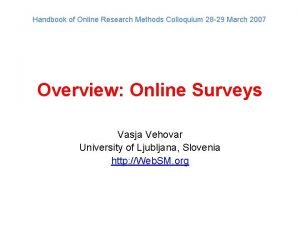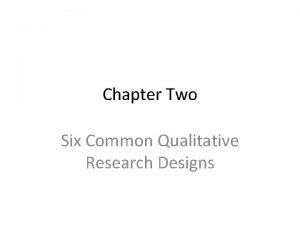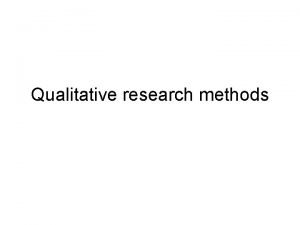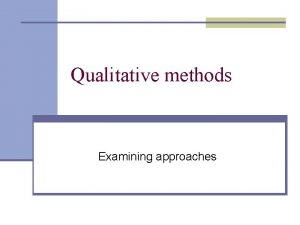Qualitative Research Methods Types of Qualitative Research Methods
























- Slides: 24

Qualitative Research Methods

Types of Qualitative Research Methods • • • Observations Interviews Case Studies

General Characteristics (Coolican, 2004) • Provide a rich range of information • Subjective • Reflect the natural environment of behavior • Loosely structured (or unstructured) • High ecological validity

General Characteristics (cont) (Coolican, 2004) • High in reflexivity • Close contact between researchers and participants helps for understanding meaning and context • They are an emic approach to understanding behavior by investigating the unique perspective of people

General Characteristics (cont) (Coolican, 2004) • Research strategies are flexible and are conducted in the real world • Data analysis focuses on themes that emerge from the data

General Characteristics (cont) (Coolican, 2004) • Uses Purposive Samples • • Selects participants with specific characteristics for a particular purpose Allows for some generalization to a larger group Snowball samples Theoretical samples

OBSERVATIONS

Characteristics of Observations • Observers view people in natural settings • Observers collect data that goes beyond objective facts and write detailed observations called thick descriptions • Data are analyzed with inductive content analysis

Types of Observations • Overt observations are when the researcher tells the group s/he is conducting research (ie, they know they are being observed); increases participant expectancy which may alter the participants’ natural behavior (Hawthorne Effect) • Covert observations are when the researcher pretends to be an ordinary member of the group and observes in secret. Though participant expectancy is less of a problem, ethical dilemmas occur with deception

Strengths of Observational Research • High in ecological validity (as long as researcher’s presence has not affected results) • Details accounts of behavior in natural settings • Covert observations reduce participant expectancy

Weaknesses of Observational Research • Covert observations pose ethical problems (deception) • Overt studies may increase participant expectancy

INTERVIEWS

Characteristics of Interviews • Purpose is to get someone’s point of view by asking questions • Often is the only way to get insights into the nature of subjective experiences and interpretations • Used to understand the meanings participants attach to certain events (ie grades) • Useful when topic is too sensitive for people to discuss in a group setting

Types of Interviews • Structured * Semi-structured • Unstructured

Semi-Structured Interviews • Researchers have a specific topic but questions are not asked in the same way to all participants • Meant to be flexible and interactive with follow-up questions • Can be done one-to-one or in focus groups • Some use narratives (where participants tell their story) and/or vignettes (hypothetical examples)

Focus Groups How Do Focus Groups Work? https: //www. youtube. com/watch? v=3 Twg. VQIZPsw A Samsung Chromebook Focus Group https: //www. youtube. com/watch? v=q. C_4 u. F 2 b. HJA

Inductive Content Analysis (Thematic Analysis) • Interviews are transcribed using verbatim transcription or postmodern transcription • Transcripts are organized into categories according to emerging themes • Summary tables of themes is prepared • Conclusions are formulated

Strengths of Interviews • Good way to get someone’s point of view • Provides a rich account of someone’s experience • Detailed responses more likely • Using vignettes allow people to “tell their story”

Weaknesses of Interviews • Reliability (producing similar results) can be poor since different studies might use different questions • Focus group interviews may produce extreme responses • Narrative vignettes make coding a challenge • Researcher bias and demand characteristics can pollute data

CASE STUDIES

Characteristics of Case Studies • Idiographic- concentrating on unique traits of individuals or groups • Uses multiple sources of evidence for gathering case study data • • Letters, emails, diaries Archival records Interviews Observations

Types of Case Studies Intrinsic • Unusual or interesting (ie, feral children) • Not easily generalized to a larger population Extrinsic/Instrumental • Examine how individual or group experiences fit with larger theory (ie cognitive therapy) • More easily generalized

Strengths of Case Studies • Best choice for giving detailed descriptions of an event, organization or progress of a patient in therapy • Sensitive to context • Use multiple sources of data • Helps researchers develop new theories • May be only way to study a unique behavior (ie, brain damage)

Weaknesses of Case Studies • Ethical problems (confidentiality and anonymity) often plague case studies • Poor population validity since data comes from specific people or groups • Researcher bias can be a problem if s/he does not objectively select data sources • Time consuming
 Qualitative analysis political science
Qualitative analysis political science Methodology errors
Methodology errors What is purposive sampling in qualitative research
What is purposive sampling in qualitative research Visual methods in qualitative research
Visual methods in qualitative research Qualitative research methods
Qualitative research methods Sampling methods in qualitative and quantitative research
Sampling methods in qualitative and quantitative research Qualitative research methods
Qualitative research methods Qualitative research methods
Qualitative research methods Qualitative research methods
Qualitative research methods Types of qualitative design in research
Types of qualitative design in research Appendix example in research
Appendix example in research Components of chapter 3
Components of chapter 3 Qualitative research
Qualitative research Methods of consumer research
Methods of consumer research Types of theological research methods
Types of theological research methods Characteristics of qualitative approach
Characteristics of qualitative approach Integrating qualitative and quantitative methods
Integrating qualitative and quantitative methods Qualitative forecasting methods
Qualitative forecasting methods Direct wax pattern
Direct wax pattern How many types of qualitative reduction
How many types of qualitative reduction Does qualitative research have hypothesis
Does qualitative research have hypothesis Chapter 10 qualitative research designs
Chapter 10 qualitative research designs Is an explanation
Is an explanation Instruments in quantitative research
Instruments in quantitative research Methodological integrity in qualitative research
Methodological integrity in qualitative research













































